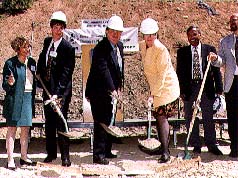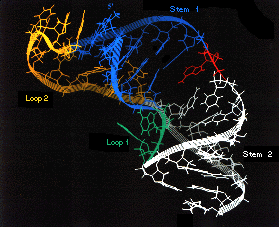





| 
| 
| 
| 
|

|
The groundbreaking ceremony for the Human Genome Laboratory. (From left) Life Sciences Director Mina Bissell, Life Sciences' Chris Martin, Lab Director Charles Shank, DOE's Martha Krebs, interim Human Genome Center Director Mohan Narla, and Mike Palazollo, deputy director of the Human Genome Center. |
 Thanks to the film Jurassic Park, the whole world has learned that PCR-the
polymerase chain reaction-is the method by which scientists replicate millions of
copies of a DNA fragment. In addition to its growing role in forensic analysis,
the PCR technique is essential to all genetic research, including the genome
project. In 1995, Berkeley Lab scientists and engineers at the Human Genome
Center announced the development of an improved type of apparatus, called a
"rapid thermal cycler," that can cut in half the time required to perform PCR. A
next-generation rapid thermal cycler, in its final stages of development, will be
even faster and could lead to the complete automation of the PCR process-a step
most HGP researchers say is critical.
Thanks to the film Jurassic Park, the whole world has learned that PCR-the
polymerase chain reaction-is the method by which scientists replicate millions of
copies of a DNA fragment. In addition to its growing role in forensic analysis,
the PCR technique is essential to all genetic research, including the genome
project. In 1995, Berkeley Lab scientists and engineers at the Human Genome
Center announced the development of an improved type of apparatus, called a
"rapid thermal cycler," that can cut in half the time required to perform PCR. A
next-generation rapid thermal cycler, in its final stages of development, will be
even faster and could lead to the complete automation of the PCR process-a step
most HGP researchers say is critical.
 Not all diseases are genetic in origin. Many of the worst are caused by
viruses and retroviruses, the most notorious of which is HIV. A retrovirus is a
protein-coated packet of RNA (ribonucleic acid) that requires the chemicals of a
host cell to make viral DNA and proteins from its RNA genome. When a retrovirus
invades a cell it synthesizes enzymes that transform the host into a virus
replication factory. A major handicap in the medical fight against retroviruses
has been a lack of information on the mechanism by which they are able to
replicate within host cells. Berkeley Lab scientists, however, have succeeded in
producing the first three-dimensional image of an RNA structure crucial to the
mechanism. The structure, a double looped strand of RNA that forms what is called
a "pseudoknot," was revealed to contain a bend in its shape that may serve as the
site where key host proteins interact. Armed with this knowledge, pharmaceutical
researchers can now work to design drugs that fight retroviruses by binding to
the pseudoknot at this site and blocking these interactions.
Not all diseases are genetic in origin. Many of the worst are caused by
viruses and retroviruses, the most notorious of which is HIV. A retrovirus is a
protein-coated packet of RNA (ribonucleic acid) that requires the chemicals of a
host cell to make viral DNA and proteins from its RNA genome. When a retrovirus
invades a cell it synthesizes enzymes that transform the host into a virus
replication factory. A major handicap in the medical fight against retroviruses
has been a lack of information on the mechanism by which they are able to
replicate within host cells. Berkeley Lab scientists, however, have succeeded in
producing the first three-dimensional image of an RNA structure crucial to the
mechanism. The structure, a double looped strand of RNA that forms what is called
a "pseudoknot," was revealed to contain a bend in its shape that may serve as the
site where key host proteins interact. Armed with this knowledge, pharmaceutical
researchers can now work to design drugs that fight retroviruses by binding to
the pseudoknot at this site and blocking these interactions.
 |
A double looped strand of RNA forming a "pseudoknot." The presence of adenosine (red) between two stems of a pseudoknot creates a bend in the pseudoknot's shape that helps retroviruses reproduce. |
 RNA is the workhorse for the entire genetic world, not just retroviruses. It
transcribes the coded instructions of DNA and assembles amino acids into proteins
accordingly. Biologists know that RNA can fold back on itself and assume a
variety of complex "secondary" shapes to carry out its myriad biological tasks.
As was the case with retroviruses, however, there has been little or no detailed
information on the various forms these critical secondary RNA structures take.
Again, Berkeley Lab scientists have been pushing the knowledge envelope. Working
with x-ray crystallography, a technology that traditionally has only been used to
determine the shapes of protein structures, they have produced some of the
clearest images ever obtained of RNA secondary structures. These images revealed
that uracil, one of the four types of nitrogenous "bases" that represent the
letters of the genetic code, can pair off with any other letter, including
itself. This not only contradicts the exclusive two-letter base-pairing pattern
in DNA, it helps explain why RNA is so flexible and why, unlike DNA which has
only one form (the double helix), it can take on so many different shapes. The
images and the information they have yielded have been made available to
scientists throughout the country. With this knowledge, it might soon be possible
to study, and possibly control, the functions of secondary RNA structures, a
capability that would have enormous ramifications for the field of medicine.
RNA is the workhorse for the entire genetic world, not just retroviruses. It
transcribes the coded instructions of DNA and assembles amino acids into proteins
accordingly. Biologists know that RNA can fold back on itself and assume a
variety of complex "secondary" shapes to carry out its myriad biological tasks.
As was the case with retroviruses, however, there has been little or no detailed
information on the various forms these critical secondary RNA structures take.
Again, Berkeley Lab scientists have been pushing the knowledge envelope. Working
with x-ray crystallography, a technology that traditionally has only been used to
determine the shapes of protein structures, they have produced some of the
clearest images ever obtained of RNA secondary structures. These images revealed
that uracil, one of the four types of nitrogenous "bases" that represent the
letters of the genetic code, can pair off with any other letter, including
itself. This not only contradicts the exclusive two-letter base-pairing pattern
in DNA, it helps explain why RNA is so flexible and why, unlike DNA which has
only one form (the double helix), it can take on so many different shapes. The
images and the information they have yielded have been made available to
scientists throughout the country. With this knowledge, it might soon be possible
to study, and possibly control, the functions of secondary RNA structures, a
capability that would have enormous ramifications for the field of medicine.

| 
| 
| 
|